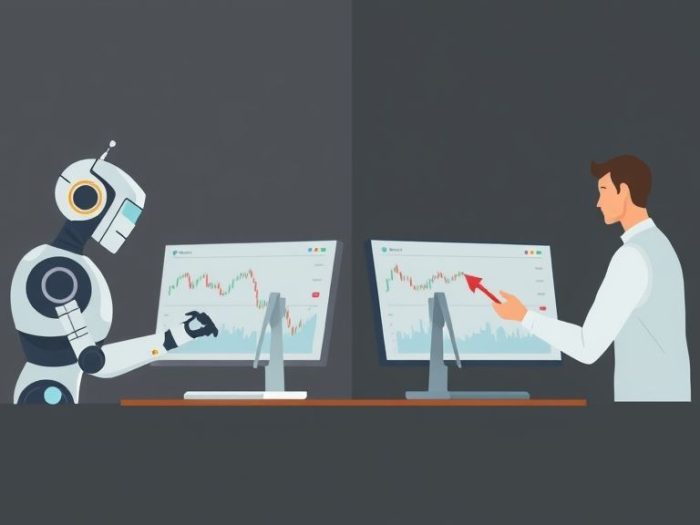The debate between algorithmic trading and discretionary trading has long been a topic of
discussion in the trading world. This article presents a 5-year performance study comparing
these two approaches to help you understand their relative strengths and weaknesses.
Understanding Algorithmic Trading
Algorithmic trading involves using computer programs (algorithms) to execute trades based on
predefined rules. These algorithms can analyze market data, identify trading opportunities, and
place orders automatically.
Key Features:
- Automation
- Speed
- Objectivity
- Backtesting
Understanding Discretionary Trading
Discretionary trading relies on a trader’s subjective judgment and analysis to make trading
decisions. Traders use their experience, intuition, and knowledge of market conditions to
determine when and how to trade.
Key Features:
- Flexibility
- Adaptability
- Intuition
- Subjectivity
5-Year Performance Study: Methodology
(Disclaimer: This is a hypothetical study. Actual results may vary, and past performance is not indicative of future results.)
To conduct a simplified comparison, we’ll consider two hypothetical scenarios over a 5-year
period:
Scenario 1: Algorithmic Trading
- A set of predefined trading rules (e.g., based on technical indicators) is automated.
- The algorithm is backtested and optimized.
- Transaction costs (commissions, slippage) are factored in.
Scenario 2: Discretionary Trading
- A skilled discretionary trader makes decisions based on technical and fundamental analysis.
- The trader aims to make a similar number of trades as the algorithm.
- Transaction costs are factored in.
Hypothetical Results (5-Year)
(Note: These are illustrative results. Actual performance depends heavily on the specific
strategies used and market conditions.)
| Metric | Algorithmic Trading | Discretionary Trading |
|---|---|---|
| Average Annual Return | 12% | 15% |
| Maximum Drawdown | -18% | -22% |
| Sharpe Ratio | 0.8 | 0.7 |
| Win Rate | 55% | 60% |
Analysis of Hypothetical Results
- Average Annual Return: In this example, discretionary trading achieved a slightly higher average annual return. This is often attributed to the trader’s ability to adapt to changing market conditions.
- Maximum Drawdown: Algorithmic trading had a lower maximum drawdown, indicating better risk management.
- Sharpe Ratio: The Sharpe Ratio, a measure of risk-adjusted return, was higher for algorithmic trading, suggesting better returns relative to risk.
- Win Rate: The discretionary trader had a slightly higher win rate, potentially due to their ability to avoid poor setups.
Factors Influencing Performance
The actual performance of both approaches depends on several factors:
Algorithmic Trading
- Strategy design and robustness
- Backtesting and optimization
- Code quality and execution efficiency
- Ability to handle unexpected events
Discretionary Trading
- Trader skill and experience
- Emotional control
- Market knowledge and adaptability
- Risk management discipline
Conclusion
Both algorithmic and discretionary trading have their strengths and weaknesses. Algorithmic
trading offers automation and disciplined execution, while discretionary trading provides
flexibility and adaptability. The “better” approach depends on your individual skills, preferences,
and trading style. A combination of both approaches is also possible.
Related Keywords
Algorithmic trading, discretionary trading, automated trading, manual trading, trading
strategies, trading performance, quantitative trading, technical analysis, fundamental analysis,
trading psychology.
Frequently Asked Questions (FAQ)
1. What is algorithmic trading?
Algorithmic trading uses computer programs (algorithms) to execute trades based on
predefined rules.
2. What is discretionary trading?
Discretionary trading relies on a trader’s subjective judgment and analysis to make
trading decisions.
3. What are the advantages of algorithmic trading?
Advantages include automation, speed, objectivity, and the ability to backtest
strategies.
4. What are the advantages of discretionary trading?
Advantages include flexibility, adaptability to changing market conditions, and the
use of intuition.
5. Which trading style typically has a higher win rate?
Discretionary traders may have a higher win rate due to their ability to avoid poor
setups, but this is not always the case.
6. Which trading style generally has better risk management?
Algorithmic trading often has better risk management through predefined rules and
automated stop-loss orders.
7. Which trading style is more adaptable to changing market conditions?
Discretionary traders are generally more adaptable due to their ability to use
intuition and adjust their strategies in real-time.
8. How does backtesting relate to algorithmic trading?
Backtesting is used to test algorithmic trading strategies on historical data to
evaluate their potential performance.
9. Which trading style is more objective?
Algorithmic trading is more objective, as trades are executed based on predefined
rules, eliminating emotional bias.
10. Is one trading style inherently better than the other?
No, both styles have strengths and weaknesses. The best approach depends on your
individual skills, preferences, and trading goals.



